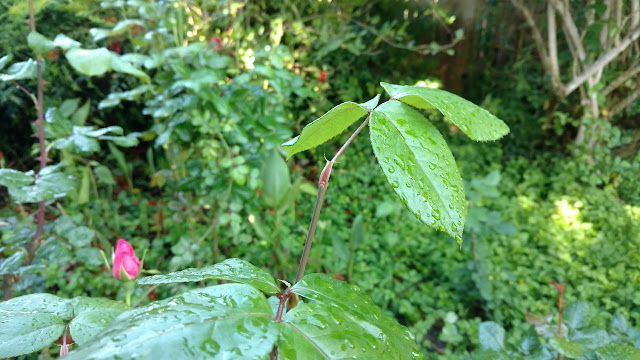

|
|
A blind shoot on this Miss Congeniality rose will never produce a flower, even though there are blooms elsewhere on the bush. (Photo: Debbie Arrington)
|
Usually, June is full of roses in my Sacramento garden. It’s the second wave of bloom after the big burst of first roses in April.
But not this year. Where there should be buds, there are only stubs.
Those are “blind shoots,” growth that never produces a flower.
In early May, I dutifully deadheaded spent blooms to prepare the bushes to generate new buds. But May’s confusing weather – triple-digit one week, 30 degrees cooler the next – created equally confused plants. Is it August? Is it March?
The stems look healthy with lots of foliage and fast growth. But no matter how long those stems grow, they won’t sprout a bloom.
Blind shoots are the result of extreme fluctuations in temperature and growing conditions. Our yo-yo
weather confused many bushes, especially when temperatures plunged back below normal.
Another oddity: Blind shoots can appear on the same bush with normal blooming stems.
Some rose varieties are more sensitive to temperature fluctuations than others. But this week, I’ve seen blind shoots on more than 100 bushes in my own garden. They’re appeared on almost every hybrid tea in my garden as well as most of the floribundas and many miniatures. Even the David Austin shrub roses have blind shoots.
This is a condition on modern reblooming roses, which covers most varieties commonly grown in home gardens. Old garden varieties introduced more than a century ago include many once-blooming roses such as Lady Banks banksia roses or Dorothy Perkins ramblers. Their growth after initial spring bloom is all foliage, no buds.
But modern roses are valued for their reblooming qualities. And an abundance of blind shoots will prevent the bush from producing new buds this summer.
Fortunately, the cure for blind shoots is easy: Prune them off. Restart the growth by cutting the cane or shoot back about 5 or 6 inches, snipping about 1/2-inch above a leaf with five leaflets.
So, I’m back deadheading my roses again, but all I’m snipping off this round are a bunch of stubs. Hopefully, if weather cooperates, I’ll have a new round of blooms – in August.
Comments
0 comments have been posted.Sacramento Digs Gardening to your inbox.
Sites We Like
Garden Checklist for week of May 5
Survey your garden after the May 4 rainstorm. Heavy rain and gusty winds can break the neck of large flowers such as roses. Also:
* Keep an eye on new transplants or seedlings; they could take a pounding from the rain.
* Watch out for powdery mildew. Warmth following moist conditions can cause this fungal disease to “bloom,” too. If you see a leaf that looks like it’s dusted with powdered sugar, snip it off.
* After the storm, start setting out tomato transplants, but wait on the peppers and eggplants (they want warmer nights). Pinch off any flowers on new transplants to make them concentrate on establishing roots instead of setting premature fruit.
* Trim dead flowers but not leaves from spring-flowering bulbs such as daffodils and tulips. Those leaves gather energy to create next year's flowers. Also, give the bulbs a fertilizer boost after bloom.
* Pinch chrysanthemums back to 12 inches for fall flowers. Cut old stems to the ground.
* Mulch around plants to conserve moisture and control weeds.
* From seed, plant beans, beets, cantaloupes, carrots, corn, cucumbers, melons, pumpkins, radishes and squash.
* Plant onion sets.
* In the flower garden, plant seeds for asters, cosmos, celosia, marigolds, salvia, sunflowers and zinnias. Transplant petunias, zinnias, geraniums and other summer bloomers.
* Plant perennials and dahlia tubers for summer bloom.
* Don’t wait; plant summer bulbs, such as gladiolus and tuberous begonias.
* Harvest cabbage, lettuce, peas and green onions.